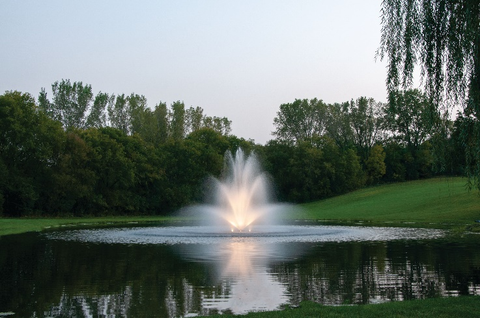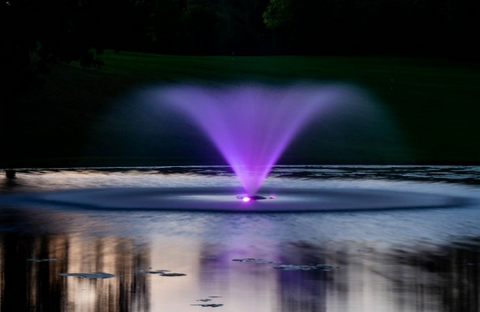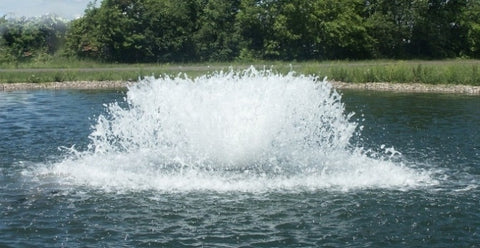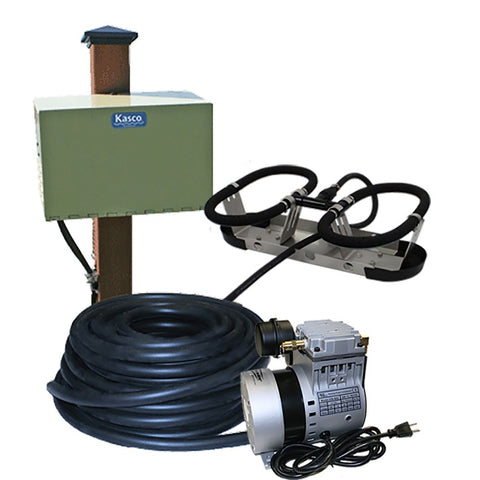Ponds fountains are desired for aesthetic reasons, but they also provide benefits to the health of your pond and fish. Pond fountains agitate the water and aerate it as well as creating a beautiful display. Before purchasing and installing a new pond fountain, it is crucial that you first consider the purposes in order of priority for you.
Pond Fountain Decoration versus Pond Fountain Aeration
Unfortunately, there truly is a tradeoff. If your primary purpose of your pond fountain is decoration/display, then by all means buy a display, or decorative, pond fountain. If your sole purpose is aeration, you do not need a fountain at all but instead a surface aerator (for ponds less than 7 feet deep) or a pond diffusion system (for ponds greater than 7 feet depth on average). Most people seek both display and aeration, but there are caveats that apply to this balanced choice.
What We Can Learn from Aquaculture Research
Though everyday pond owners don’t think of ponds in the same way as aquaculturists, aquaculturalists specialize in pond health and we can learn a lot from them. According to the US Department of Agriculture, “The broad term ‘aquaculture’ refers to the breeding, rearing, and harvesting of plants and animals in all types of water environments, including ponds, rivers, lakes, and the ocean.” Think of aquaculture as agriculture for water bodies. Aquaculture specialists are in a business and thus they are very conscious of what works best to provide healthy water environments.
Dissolved oxygen (DO) is a super-important term to know in regards to pond ecosystem health. Dissolved oxygen is necessary for healthy pond life. The largest supply comes from air in the atmosphere, which is 21% oxygen, and photosynthesis, in which plants and some other organisms use sunlight to synthesize food from carbon dioxide and water and generate oxygen as a byproduct. In some natural settings, nature itself creates enough oxygen for a healthy pond devoid of scum, unwanted algae, and noxious odors and the presence of healthy environment for fish. However, it is quite often necessary to supplement the natural environment with artificial aeration.
Oxygen is dissolved much more quickly in the pond from surface agitation from wind or by using a surface pond aerator or fountain. Either of these mix air and water together much more quickly and efficiently than if they were not present. Thus, a surface aeration or bottom aeration system are often needed to increase dissolved oxygen for the benefit of the pond ecosystem.
When Pond Balance is Most at Risk
According to Texas A & M University, “most oxygen depletions occur in warm weather, usually June-September.” There is less oxygen in warm water than cool water, and if there is not enough oxygen fish kills could occur. On top of that, fishes’ metabolic rates increase in warm water, requiring more oxygen to survive.
Several cloudy days in a row can also cause even more oxygen depletion, especially in hot, windless weather. Sunlight is necessary for photosynthesis to occur. When ponds are thermally stratified, with a warmer layer of water at the top and a cooler layer at the bottom, a summer rainstorm or cold winds could mix the layers, causing the muck at the bottom of the pond to breakdown too quickly, lowering oxygen levels and causing algae blooms. Dissolved oxygen stratification is another form of stratification that occurs in ponds, with more dissolved oxygen being present in the top layer of the pond and less at the bottom layer. The greater the depth of the pond, the bigger the difference in DO at the top of the pond and the bottom.
An Interesting Comparison of Pond Size in Southern and Northern Latitudes
Interestingly, the USDA states that “aquaculture ponds in the northern United States…have features that differentiate them from aquaculture ponds in southern climates.” Ponds in the northern states are quite often smaller (1/4-10 acres) and deeper (6-12 feet) than ponds in the southern states (1/4-50 acres, 3-8 feet). This difference can help one to decide whether to use surface aeration or bottom aeration for the pond. If aeration is your primary purpose, you will need to pay close attention to pond depth, as we will discuss in more detail later in the article.
How to tell if Your Pond is Oxygen Deprived
According to the USDA, you might conclude there is oxygen deprivation in your pond via observations such as these:
- Fish swim at the surface gulping for air
- Fish stop feeding
- Water color changes to brown, black, or gray
- Noxious odors arise from the pond
- Weather is cloudy and hot for extended period of time
- Summer rainstorms, heavy winds
“Aerator performance is measured as either standard oxygen transfer rate (SOTR) or standard aeration efficienty (SAE).” (according to USDA.) If you are focusing on a decorative pond fountain that still produces a great deal of aeration, we recommend seriously considering a Kasco fountain, as Kasco engineers constantly monitor rates of oxygen transfer. If desired, we will get you the SAE specifications for any particular unit. Kasco surface aerators deliver up to 3.0 lbs of oxygen per horsepower per hour!
Benefits of Pond Aeration

As stated above, proper pond aeration prevents stratification in the ponds. It prevents both thermal stratification and oxygen stratification.
Benefits of Pond Aeration:
- Prevents Fish Kills|
- Prevents undesirable algae blooms
- Gets rid of undesirable, putrid odors
- Prevents Mosquito Breeding
- Decreases Muck buildup at bottom of pond
- Clarifies water

Fish Kill image on left and pond scum image on right by permission of Kasco Marine
Aeration Prevents Pond Turnover
Turnover is the process of a stratified pond mixing its layers. This event usually occurs in the summer and fall, though there are exceptions. Aeration keeps the water mixed year-round, so the pond isn’t suddenly shocked by a sudden turnover mix. The temperature of the pond is evened out at different depths and dissolved oxygen is spread around to different pond depths. The bacteria that are good for a pond’s health multiply and undesirable bacteria forms are decreased. Bottom muck decomposes and this insures that fewer noxious gases rise to the top, clarifying the water and reducing reproduction of invasive plants.
The Seasonal Progression of a Pond provided by Kasco

provided by Kasco
Surface Aeration versus Bottom Aeration
Surface aeration is the most common type of aeration of ponds. This kind of aeration works well for ponds with an average depth of less than 7 feet. For ponds with a greater average depth than 7 feet, bottom aeration is required.
Three Kinds of Surface Aeration
In surface aeration, a pump is attached to a float which rises and lowers with the changing water level. The float is tied either to cinder blocks at the bottom or with ropes going to the shoreline. The pump agitates the water below and water is forced into the air so that the pond’s water is always being recirculated and oxygenated. There are three kinds of surface aeration, and each kind aerates at a different rate.
Display (or Decorative) Pond Fountain Aerators

Decorative fountains use nozzles to create a pattern. Most kits include multiple nozzles that can easily be changed. This type of surface pond aerator creates the most dramatic displays, but the drawback is that they produce the least aeration of the three kind of pond fountains. The pumps use impellers to create pressure, but the nozzles restrict flow by design. With less flow there is less oxygenation. Depending on what brand and model your purchase, decorative pond fountains might not accomplish much aeration because of the restriction of water volume discharged from the pump. Tall displays tend to require smaller holes in the nozzle to reach great heights. Some companies provide very tall or very wide displays, but to get that water so high and wide the nozzles are restricting quite a bit of flow.
Aerating Fountains

Aerating Fountains provide only one kind of display, the V-pattern. The flow of water is created by a propeller pump, not an impeller pump, and no nozzle is used; thus, restriction of flow is greatly reduced. The shape of the propeller creates the V-pattern, not a nozzle.
Surface Aerators Without Display

A Surface Aerator (no display)
Plain Surface Aerators provide the most aeration of the three kinds of surface aerators. They also use a propeller instead of an impeller, but they provide even more aeration than an aerating fountains. Common applications include:
- Commercial aquaculture
- Residential ponds and lakes when no display is required
- Retention ponds
- Leachate ponds
- Industrial and wastewater lagoons
Aeration Capabilities of Decorative Fountains, Aerating Fountains, and Aerators
Kasco recommends:
|
Pond Size |
Decorative Fountain |
Aerating Fountain |
Aerator |
|
½ acre |
1 HP |
¾ HP |
½ HP |
|
1 acre |
2 HP |
1 ½ HP |
1 HP |
|
2 acre |
4 HP |
3 HP |
2 HP |
|
3 acre |
6 HP |
4.5 HP |
3 HP |
|
5 acre |
10 HP |
7.5 HP |
5 HP |
*These recommendations above are for Kasco units only. Different brands use different pump and nozzle combinations and these figures do not work for them!
Bottom Aeration Using Pond Diffusers

For deep ponds (over 7’ in average depth) bottom aeration, or a diffuser system, is recommended for proper aeration of pond at various depths. Typically, an air compressor is located at the shore and pushes air through weighted air lines that sit at the bottom of your pond and connect to one or more diffuser assemblies. Kasco diffuser systems are the most efficient and quiet on the market and provide maximum oxygen transfer and beneficial mixing to prevent algae, weed overgrowth, noxious odors, fish kills, and other issues bad for pond health.

How to Calculate Pond Size
Surface Aeration
For surface aeration, you do not need to calculate acre feet. You only need to calculate surface area (length x width). Surface acreage can be calculated by this formula:
- Length x width ÷ 43,560
- Thus, 100 wide by 100 long= 10,000
- 10,000 ÷ 43,560 = .23 acres (about ¼ acre pond)
Bottom Aeration
To calculate bottom aeration, you need to know how many acre feet are in your pond. As a basic rule of thumb, acre feet are calculated like this:
- One acre foot=1 acre of surface water that is 1 foot deep.
- Acre foot= Surface acreage x average pond depth
- Thus, a 10-foot deep pond an acre in size is 10 acre feet.
But for bottom aeration calculations get tricky because pond depth makes a great deal of difference. If you need bottom aeration, we strongly encourage you to contact us so that we can have the calculations done for you for proper sizing. For example, if you have a round pond that is 1 acre in surface size, a single diffuser system will work if it is 15’ deep, but if it’s only 10’ deep, you will likely need two for the same surface area. Before ordering a bottom aeration system, we strongly recommend you contact us with details about your pond’s shape, size, and depth. We then get Kasco involved before we can make an official ruling on what is best for your particular pond.
Use Our Pond Size Calculator
The easiest way to calculate pond size is to use our handy pond size calculator. This calculator will figure out total surface acres of your pond, total acre feet, total gallons of water, and estimated electrical costs to run the pump.
About Solar Aeration
We get many calls about solar aeration. We understand because it is very expensive to run wire out to a distant pond. But we do warn you that these units are expensive and work best, of course, with lots of sun. In order to use the units when it’s cloudy or dark, batteries must be used and these go bad over time. We don’t mean to discourage you, but do wish to imparts the facts. Don’t be alarmed by an approximately $8,000-10,000 price tag for a 1/2HP unit.

A Kasco Solar Aerator
Summary
We realize that purchasing pond fountains and aerators is expensive and requires a lot of thought. Fountain Mountain has been around since 1999 and we are more than happy to advise you or get the best advice we can if we don’t know the answer ourselves. Our company manufactures a discount line of pond fountains. We also sell Kasco pond fountains and aerators, as well as Scott aerator products. We will work hard to get you the best option for your budget and pond needs.
References:
“Agricultural Engineering Technical Note No. AEN, July 2011.” U.S. Dept. of Agriculture.
“Oxygen Depletions in Farm Ponds: Causes, Signs and Correction” by Billy J. Higginbotham;.Cooperative Extension Program. Prairie View A&M University.

